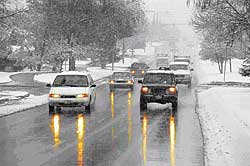Winter Light and Photography
| Almost everyone who lives in areas of winter snow has experienced a momentary feeling of blindness when looking out into the brightly lit and snow filled landscape. This is due to the uninterrupted sun reflecting off the billions of crystals and prisms created by the snow on the ground, and it can create some tricky issues where photography is concerned.
There are also other times of day that occur during the winter months, and these are far more photogenic and yet also present their own special requirements for documenting in photographs. The “sweet light” hours around dusk and dawn are some of the most dramatic instances of winter light. Quite often the skies are remarkable variations of purple, gold, orange and blue all at the same instant and this light can be broadcast across the snow or it can create the deepest and richest shadows imaginable. Can such moments be recorded by cameras? Absolutely, but it does take some preparation and planning on the part of the photographer. The first thing to remember is that the shot may require an exposure long enough to demand the use of a tripod. If a blurry effect is desired a photographer can forget the tripod, otherwise the cold weather and the darker environment will generally demand the tripod to prevent the image from being ruined. The next consideration is the location of the sun. During the morning and late afternoon hours a photographer will quickly identify where and when the shadows are the most photogenic or dramatic. This is usually when the sun is at a low angle with the ground, and most images are best created when the sun is also at a right angle from the photographer. This is because there will be no issues around underexposure brought about by the sun shining directly into the camera’s meter. Winter scenery in such light will present a nice range of warm or cool colors depending upon the time of day and the conditions. The photographer should be aware of how rapidly the light can change in the winter season and allow themselves at least a ten minute window for their work. Additionally, the composition of such shots requires balance. While the dramatic sunset may seem like an ideal object to fill the view finder, most photographers will work in a fair portion of foreground in which to balance and enhance the appearance of such a scene. For example, the majestic colors of the sunrise in winter might be greatly enhanced if the surrounding fields, hills or even buildings are within the frame as well. Amy. Editors note: Amy not only regularly contributes to this site, but also publishes a very highly regarded monthly digital photography eZine ? packed with powerful photography secrets and accompanied by video tutorials. Highly Recommended! |
Join in and write your own page! It's easy to do. How? Simply click here to return to Articles.

